Discovering unusual white spots on your beloved aquarium fish can be alarming. Whether they manifest as small dots or large patches, these spots could indicate the presence of a common pathogenic parasite known as ich or ick. However, not all white spots are caused by this parasite. In this comprehensive guide, we’ll explore the various reasons behind these skin diseases affecting your fish, and potential cures.

One day you pass by your aquarium and notice that your goldfish or Betta is covered in something unusual.
Be they large or small, any form of white spots appearing on the body, fins, or tail of a fish are a cause for concern.
Your pet has likely become the host of a common pathogenic parasite known as ich or ick, but that’s not always the case.
This illustrated guide will help you identify the possible reasons behind these skin diseases and offer pointers on what to do next.
Skin spot diseases are prevalent in tropical fish aquariums where these conditions progress faster because of the favorable water temperature.
The best and fastest treatment is a function of a timely, yet proper, diagnosis.
Diagnosing white growth depends on its appearance and body locations.
Does the spot look like it’s made from fuzz or a slimy film?
Would you describe it as large patches, random clusters, or tiny dots?
All of these signal different conditions which are a potential threat to a fish’s life.
Why are there white dots appearing on your aquarium fish?
If the dots appear to be tiny and round it means that the fish has contracted an external protozoan parasite that feeds off of its flesh. The mortality rate of this condition is extremely high and measures should be taken as soon as possible.
Here’s the reason behind white spots appearing on aquarium fish:
The most common cause of tiny white spots forming on the fins, gills, or body of aquarium fish is a pathogenic parasite known as ich or ick. The parasite forms microbial cysts which are sheltered under the outer skin layers of the fish, resulting in convex white lesions with a diameter of up to 0.04 inches.
Each of these bumps resembles a small white dot, which looks like a grain of salt or sugar, hence this parasitic outbreak is often referred to as white spot disease.
Unless the disease spreads outside of the gills, it will not visually manifest itself as white dots.
The next picture will help you identify ich by showing how its white round dots look like on these two goldfish:
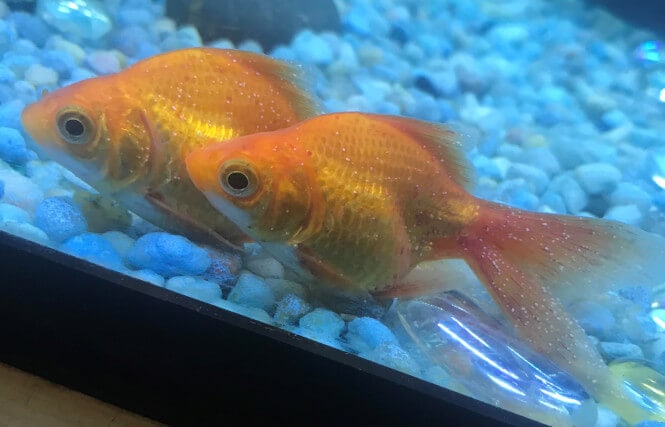
Here’s how the advanced stage of freshwater ich appears on this gourami fish:
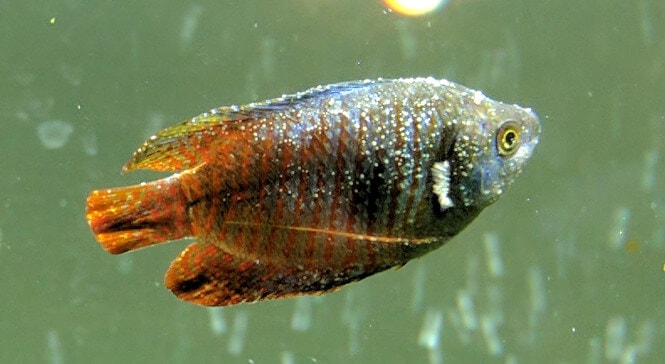
Have a look at the initial stage of marine ich manifesting itself as small dots appearing on random body locations in a Purple Tang fish:
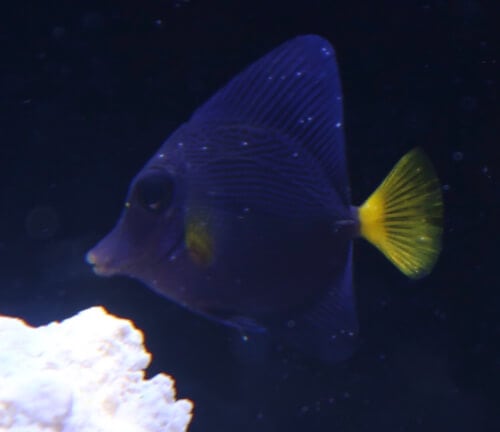
And here’s a photo of a more severe case of marine ich on another saltwater fish:
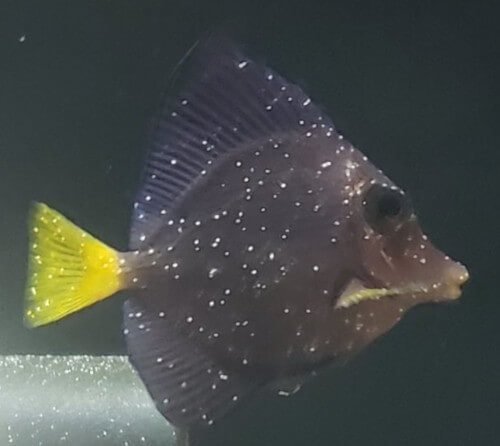
The white spot disease is known to affect the large majority of both freshwater and saltwater fish, and no species is known to have developed a natural defense mechanism against it.
White spots also called as ich or ichthyophthiriasis on the fish is a protozoal disease caused by parasite ichthyophthirius multifiliis. The parasites land on skin and gills triggering the development of tiny, whitish cysts or spots.
As they are harmless at the beginning, however with the passage of time they may become harmful, which also shows that there is an underlying infestation, if gone untreated. Furthermore, it is transmittable, causing a substantial threat to other fish in your aquarium.
To detect white-spots on fish demands critical observation. Spots are akin to salts sprinkled on your fish’s body or demonstrated as minute tiny dots. With the progression of the disease, spots become prominent and enlarged, the fish also exhibits signs of trouble like flashing or difficulty breathing.
In addition to this, infested fish may showcase other signs such as a lack of energy, loss of appetite as pathogenic parasites in the fish disrupt normal physiological activities.
If any of aforementioned signs or white spots on the fish are witnessed, then it is advisable to confirm diagnosis of ichthyophthiriasis immediately. Various laboratory tests and procedures are available to do so such as microscopic examination of skin scraps, gill biopsy to detect parasite’s presence.
Consulting with trained and experienced aquarists and veterinarians possessing knowledge of aquatic species prevent such incidents and proper diagnosis be achieved easily.
In freshwater aquariums, the disease is caused by a protozoan parasite from the group of ciliates called Ichthyophthirius multifiliis. In saltwater aquariums, the parasites responsible for what’s known as marine ich are named Cryptocaryon irritans and are also ciliated protozoans.
Both parasites share the same life cycle, however, the time to complete it varies based on water temperature, affected fish species, and water salinity.
How should you cure it?
Most commercially available chemicals that treat external protozoans such as the ones responsible for ich will show success in both freshwater and saltwater fish tanks.
For the best results, these should be combined with increasing the water temperature of the aquarium.
The commercial products will often contain malachite green, a 37% formaldehyde water solution known as formalin, copper, or any combination of three. In freshwater aquariums, I personally have had success with Hikari Ich-X for more advanced stages and Weco Nox-Ich if I happen to catch the condition in its early phase.
Click here to learn more about treating Ich in freshwater species.
The preferred methods for treating saltwater Ich are copper-based medication and inducing hyposalinity.
Learn more about the best treatment methods for Ich in saltwater species.
Ich is highly contagious among fish in confined spaces and it should be treated as soon as it is noticed. If left untreated for long enough this disease can reach up to a 100% mortality rate.
Several treatment options are to be availed of to get rid of such parasitic infestations, which are aimed at eliminating the parasite from the surrounding thus reducing the tribulations of infested fish and other aquarium species.
Treatment options for aquarium parasites include medication and medicated baths, commercial remedies, increasing water temperature to disrupt parasites’ life cycle. It is advised to follow instructions or prescriptions and monitor aquarium water parameters to ensure safety and efficacy.
Prevention of the white spot or other skin diseases in fish aquarium outbreak needs measures beforehand to sustain maximum tank conditions and reduce stress on other mates. Testing aquarium water quality, filtering water, and sanitation procedures must be maintained to mitigate the risk of disease progression and transmission in aquariums.
Skin spot diseases include a wide range of diseases causing external discomfort and surface problems in tropical fish, such as fungal infections, bacterial diseases, and pathogenic parasites in fish. Characteristic signs of these diseases are soreness or lesions on the skin, discoloration, budding or outgrowth on the skin surface, and fins or scales of infected fish.
Examples of such problems are ichthyophthiriasis in fish, fin rot, and infection due to fungi; each shows characteristic signs and requires specific treatment.
Understanding Skin Spot Diseases
Prevalence in tropical fish aquariums
Due to environmental factors and congenital conditions in tropical fish aquariums, skin spot diseases are prevalent in these areas. Raised temperatures, poor water quality, and changing water parameters can lead to stressful environments directly influencing fish immune systems, thus making them more susceptible to such diseases. Additionally, the introduction of new infected fish into the aquarium also causes the spread of disease in the aquarium.
Timely diagnosis and its importance
Diagnosing skin spot diseases timely and at the earliest stage could be a mammoth step toward preventing skin spot diseases. Eradicating skin spot diseases at the nascent stage can protect infected animals as well as other species in the aquarium. Early recognition can guide proper treatment and prevention strategies to be followed.
Treatments and Impacts
Treating and timely diagnosis of white spots on fish cannot be underestimated in aquariums. An effective treatment regime for the elimination of disease-causing agents from the aquarium is crucial to mitigating the trouble and stress of infected fish. Depending on the disease and severity of the infection, treatment choices can include medication baths, skin treatments, or the administration of medication.
Prevention
Appropriately treating the skin disease pinning on the tropical fish aquariums calls for the implementation of a system of prevention that is dependent on the fact that certain factors, such as water conditions and stressors, have to be inhibited as much as possible. Routine aquarium water quality monitoring and filtration, which are efficient enough, and careful quarantine of new arrivals can decrease the risk of pathogen’s arrival and spread. Regarding this, supplying fish with a well-balanced diet, enough space, and the proper stimulating environment play an important role in the maintenance of fish’s immune systems, which in turn makes the fish’s resistance to diseases greater.
Differentiating White Spot Diseases in Fish
Accurate diagnosis of white spots on fish is a keystone of aquarium owners’ duties, since the most different kinds of diseases may suffer from it. By making a diligent examination of the sharp spots of the spread and location, aquarists could differentiate one disease from another and use a suitable treatment method accordingly.
Polka dots on fish in appearance may have disparate sizes, shapes, and textures, and as such, they will have telltale signs of the disease.
Tiny, even pin-like species of white spots scattered on the body and fins are an indication of ichthyophthiriasis, scientifically termed white spot disease. These patterns look like salt and pepper grains and are provoked by the Ichthyophthirius multifiliis protozoa, a real parasite.
White spots that have a fluffy or cottonese-like appearance are possibly due to fungi. Mostly, fungal diseases appear on the fish skin, fins, or mouth and can spread quickly if neglected.
Bald spots, which can look like a lump or a thick bubble, are a symptom of bacterial infections like columnaris and ulcer disease. The lesions may be accompanied by inflammation, redness, or become matted.
Location of white spots on the body:
The location of white spots on fish can also provide valuable insights into the nature of the underlying different conditions.
On the body surface:
White spots spread on the entire body surface, including the fins and tail region, are related to ectoparasitic infestations in fish like ichthyophthiriasis. These parasites inhabit the skin and gills of fish, causing itching and distress.
On Mouth and Gills:
White spots present on the mouth and gill may be a sign of bacterial or fungal infections local to these areas. An infection affecting the mouth and gills may cause difficulty breathing, feeding difficulties, and other health problems.
In the majority of cases, white spots show signs that are characteristic of internal organ damage, such as the liver, kidneys, or intestines. Internal infections present white nodules visible through the skin.
Most white spots are similar, but careful observations of spots and accompanying signs and symptoms display distinction between different spots.
Fish affected by ichthyophthiriasis may scratch or rub against a rough surface to mitigate irritation. On the other hand, fish infected with fungal infections show signs of a lack of energy, a loss of appetite, or an abnormality in swimming.
Water quality has profound impacts on the breeding of parasites and other infections. Poor water quality deteriorates skin conditions. Testing water quality regularly is essential in order to ward off pathogenic attacks on fish.
Ichthyophthirius multifiliis, commonly known as Ich, is a notorious parasite responsible for causing white spot disease, a prevalent ailment affecting both freshwater and saltwater fish in aquariums. Understanding the life cycle and impact of this parasite is crucial for effectively managing outbreaks and preserving the health of aquatic inhabitants.
Ichthyophthirius multifiliis is a single-celled protozoan parasite belonging to the ciliate group. Under the microscope, it appears as a tiny, rounded organism covered in cilia, which it uses for movement and attachment.
Ichthyophthirius multifiliis can infect a wide range of freshwater aquarium and saltwater aquarium fishes, making it a significant threat in both types of aquariums.
The parasite primarily targets the skin and gills of fish, where it attaches itself and forms characteristic white spots or cysts in fish. These cysts on fish gills, containing hundreds of dormant parasites, eventually rupture, releasing free-swimming parasites into the aquarium’s water and perpetuating the infection cycle.
The white spot disease is endemic and clear evidence of its existence.
Platysichthis multifiliidus alias ich is a stomping ground parasite well-known as ich causing a deadly disease named ichthyophthiriasis in almost all freshwater and saltwater fish cultured at an aquarium. The proper knowledge of this parasite cycle and its evoked effects is fundamental when handling the illnesses of aquatic living things.
Life Cycle of Ichthyophthirius multifiliis:
The life cycle of aquarium parasites like Ichthyophthirius multifiliis begins with the free-swimming, infective stage known as the trophont. Trophonts actively seek out fish hosts and penetrate their skin, establishing infection.
Once attached to the fish, the trophont undergoes development within the skin, forming a protective cyst around itself. During this stage, the parasite feeds on the host’s tissue and grows in size.
Mature trophonts eventually rupture, releasing thousands of microscopic tomonts into the water. Tomonts settle on surfaces within the aquarium, where they undergo a period of encystment, forming protective capsules.
After a period of encystment, tomonts undergo division and produce hundreds of theronts, the infective stage responsible for initiating new infections. Theronts are released into the water, where they seek out new hosts to continue the cycle.
Effect on Freshwater and Saltwater Fish:
Ichthyophthirius multifiliis can become a real threat to fish species in freshwater aquariums, such as goldfish, tetras, and cichlids. It can spread rapidly, causing morbidity and mortality if left untreated.
These infections are less common in saltwater aquariums; they can infect species of fish in marine environments, especially those stressed or housed in inappropriate conditions. Infestation of saltwater fish can pose a serious threat to treatment and management due to differences in water and fish physiology.
Options for Freshwater and Saltwater Aquariums Whenever an outbreak of Ichthyophthirius multifiliis, commonly referred to as Ich, occurs in freshwater or saltwater fish aquariums, aquarists have numerous treatment options. These treatments include commercially prepared chemicals, medicines, and procedures aimed at eliminating parasites and other pathogenic agents.
Other Causes of White Spots in Fish
White spots are not exclusively associated with ichthyophthiriasis; numerous other diseases also show common signs and symptoms, thus requiring careful observation and differential diagnosis. Common among these are velvet diseases, lymphocystis virus, and freshwater neoplasms, each with characteristic signs, symptoms, and treatment.
What if the condition is NOT caused by Ich?
If the white formations on your fish appear like larger patches, that have a fuzzy texture, or the dots are too dense to count then you may be looking at a fungus outbreak or a bacterial infection.
The latter include deadly infections such as Columnaris.
In some cases, even viruses such as Lymphocystis will cause such symptoms. Also, before we move forward, you should know that the best way to identify a disease in our fish is by consulting with a professional veterinarian.
White spots that are NOT caused by Ich may appear on fish with the following diseases:
1- Velvet Disease
Velvet disease aka gold dust disease, demonstrates as golden dusting or velvety coating on the skin of affected fish, which is a parasitic disease, the parasite grows in poor water quality conditions. It is not to be confused with white spot as it infects the entire body of fish.
Symptoms:
- It causes dyspnea (difficulty breathing)
- Skin irritation and restlessness. Weight loss, deterioration of body conditions.
- Loss of appetite due to psychological impacts of disease.
Treatment:
It can be treated with many available treatment choices.
Copper based medication: copper-based chemicals such as copper sulfate is used for treating fish infected with velvet disease. Copper sulfate is directly introduced into the aquarium containing fish which interfere with the life cycle of parasites.
Formalin solution: aldehyde containing solution like formalin serve as best option for treatment of such disease caused by parasites. Infected fish are immersed into the formalin bath to allow the solution to penetrate the skin.
Control of Water quality and environment: water quality and the surrounding conditions have a mammoth impact on parasites life cycle, growth and reproduction, controlling water quality and maintaining a tidy and cleaned environment ward off parasitic infestation of fish.
Take a look at this photograph of a purple tang with a Velvet disease which appears to be covered in fine white powder-like particles:
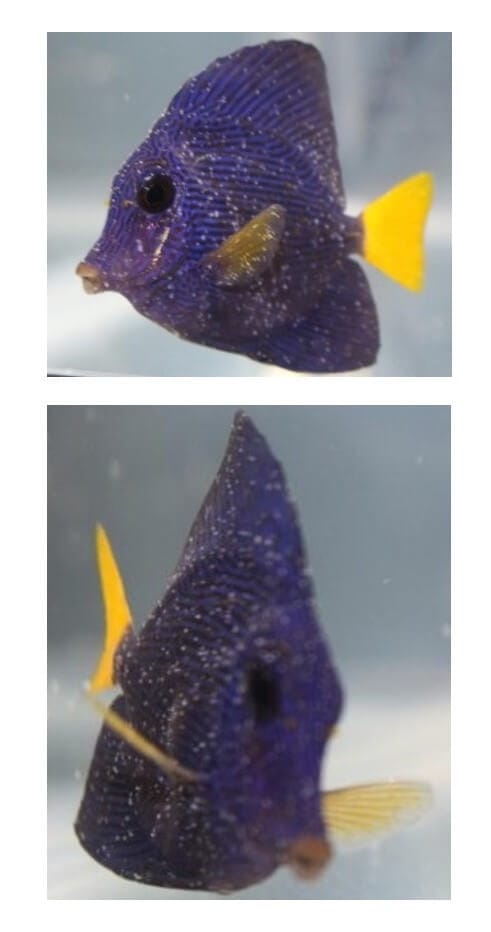
And now have a look at a Betta fish that’s infected by the freshwater Velvet parasite:
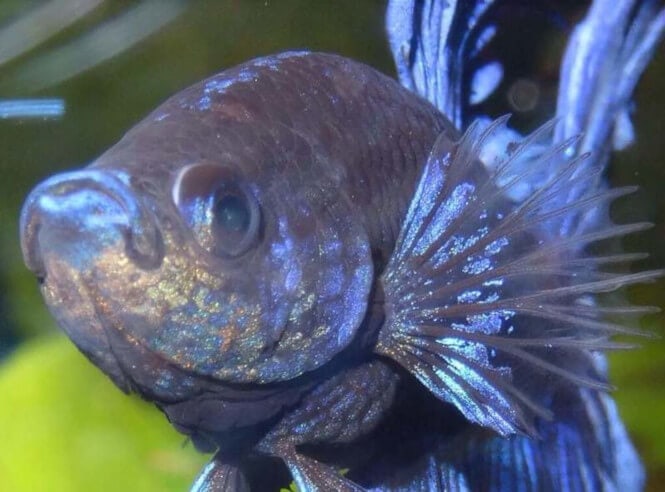
See here how the white dots appear as dust:
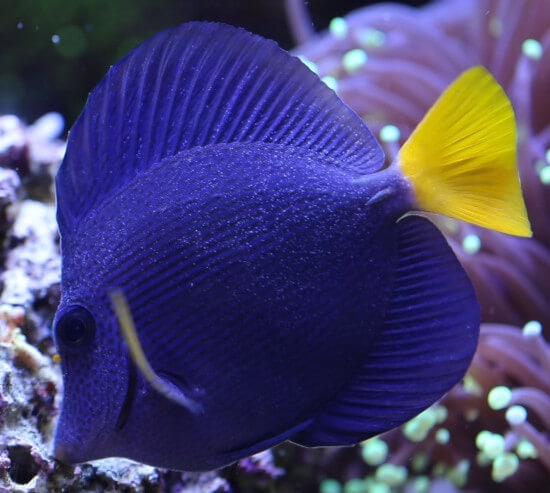
2. Lymphocystis virus
Lymphocystis virus, a viral disease caused by viruses belonging to the iridoviridae family, is characterized by white nodules or cauliflower-like growth on skin surface or sometimes internal organs. It can affect both freshwater and saltwater species of fish.
Signs and symptoms:
- Most common sign of disease is the presence of white nodules or small pinkish outgrowth on skin or internal organs of affected fish.
- Edema or swelling and inflammation.
- Disfigurement of fins or body appendages.
- Overall behavior is not affected such as appetite and lifestyle.
Prevention and management strategies:
Even though it is not transmitting and self-limiting, it can not spread easily to others but diagnosis and elimination at the earliest stage is crucial for overall health and well-being of the aquarium’s ecosystem. Various strategies are to be employed to limit and eradicate lymphocystis virus some of which are listed here.
Maintenance of favorable aquarium conditions:
Aquarium environment should be favorable for the fish with water quality improvement and ventilation so that fish can perform all physiological functions with ease including immune functions, if water quality becomes poor it will invite lymphocystis virus and as a result aquarium population will be affected.
Reduction of stressors
Stress can exacerbate signs and symptoms of lymphocystis virus and prolong the duration of infection, minimizing stressful conditions and improving the immune system is essential to fight against lymphocystis virus.
Cleaning of aquarium:
Regular cleaning activities such as removing debris, leftover materials, changing water and proper filtration of water can mitigate the likelihood of lymphocystis outbreak in aquariums.
Feed and vitamin supplements:
Adding supplements containing vitamins and feed additives can boost immune system and other functions which on their own accord limit and eliminate the disease.
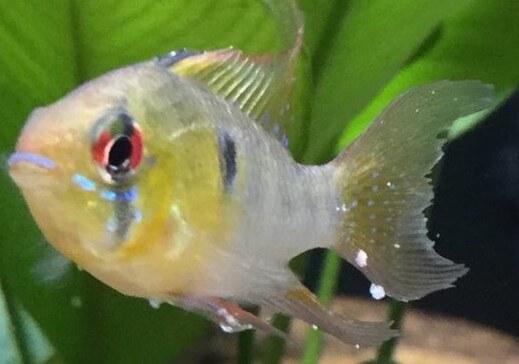
3. Freshwater Neo Ich
Neo Ich, a protozoal disease caused by the protozoan family Ichthyophthirius commonly affects freshwater species of fish. They can be attached to the skin or gills of fish and have strong resistance against conventional treatments and inhabit a relatively colder part of the aquarium.
Symptoms:
symptoms of disease may be:
- Rubbing against the surface or substratum to reduce irritation.
- Lack of energy, lethargy and loss of body condition.
- Rapid breathing and gasping.
Treatment:
it can vehemently resist the traditional treatment of ichthyophthiriasis, targeted and focused treatments should be followed such as
Malachite green : it is a dye which Stains the parasite so that they become visible. It is a strong anti-parasitic and destroys the parasite by interfering with life processes of the parasite. It is the best treatment option for Neo ich.
Acriflavine: a strong anti-parasitic medicine which can be directly administered or added into a bath can eliminate neo ich parasites.
Increasing temperature: As these parasites grow in cooler climates, by elevating the temperature of aquariums their growth and reproduction can be controlled to some extent.
Have a look at this discus fish infected with Neo ich, almost completely covered in white dots, but the cluster is not as thin as the one normal ich would cause:
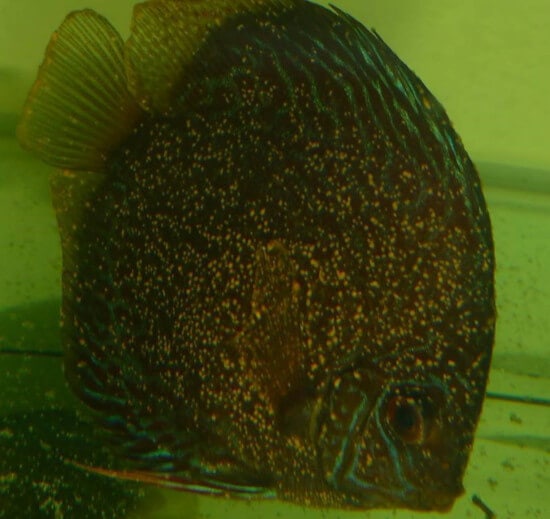
4. Brooklynella disease
Brooklynella disease is a protozoal infection, whose causative agent is protozoa brooklynella hostilis. The protozoa usually attaches to the skin or gills of fish causing excessive tissue damage and discomfort.
Signs and symptoms of disease:
Many characteristic signs denote the infection of brooklynella hostilis such as:
- Abnormal mucus production leading to respiratory problems.
- Loss of hunger, lack of movement and energy.
- Rapid gill movement and difficult breathing
- Deterioration of overall health.
Treatment :
Disinfectant: Aldehyde-based disinfectant such as formalin bath is to be used to eradicate the brooklynella hostilis, formalin penetrates into the body and disrupts the life activities of brooklynella.
Antiprotozoal medication: Metronidazole, one of the antiprotozoal medications, serves as the best choice for brooklynella treatment. Which can be fed by mixed in feed or by orally, it causes disruption of the metabolic process of pathogenic agents.
Here’s an initial stage of Brooklynella on a clownfish, forming a large spot of white mucus behind its fin:
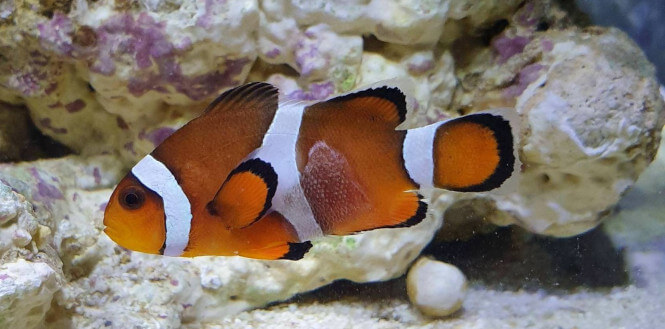
Take a look at a close-up of the film that’s covering another clownfish infected by the Brook parasite:
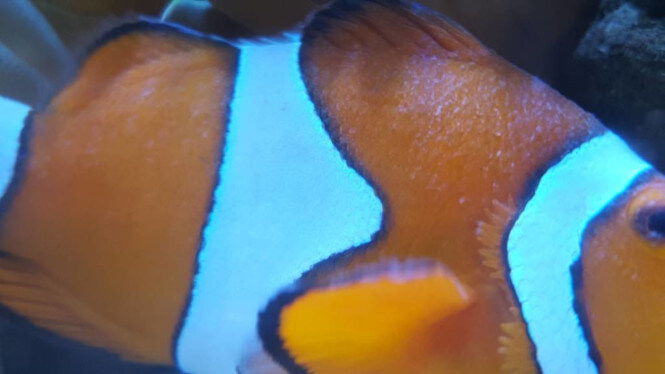
Look at a Naso Tang that has contracted the Brooklynella parasite and how the affected areas secrete white slime, appearing as if the skin is peeling off:
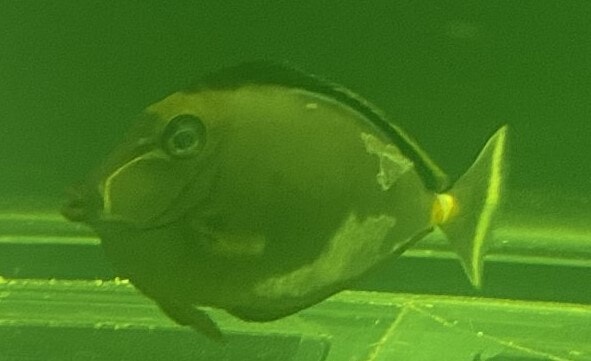
5. Stress spots on Tang Fish
Stress spots on tang fish represent a mild pigmentation or discoloration of skin of tang fish subjected to prolonged stress. It most commonly affects Naso tang.
Reasons behind stress spots:
Numerous reasons contribute to the development of stress spots on tang fish primarily interfering with psychological states of fish.some of which are here
Water quality: poor water quality and changes in properties of water such as pH change, temperature of water density of water and other unhygienic elements in water lead to the development of stress spots on fish.
Tank size: tank size has a lot to do with the growth and comfort of fish confined inside, if it is spacious fish can swim and move freely thus giving physical and mental relaxation. On the other hand if size is limited which causes suffocation of fish hence leading to many health crises like stress spots.
Behavior of tankmates in aquarium: Behavior of mates in aquarium seriously impact the lifestyle of others to which they encounter in aquarium, their aggressive behavior can lead to formation of stress spots on tang fish.
How to minimize stress spots on fish:
To minimize stress spots it is essential first to recognize the agents or reasons and then elimination of such causes. Some strategies to minimize stress spots are as follows:
- Creating a spacious tank.
- Isolation of tang fish from aggressive ones.
- Quarantining infected ones from others.
- Reducing disturbances.
- Improving water quality.
Have a look at how the white circular spots look on a stressed Naso Tang:
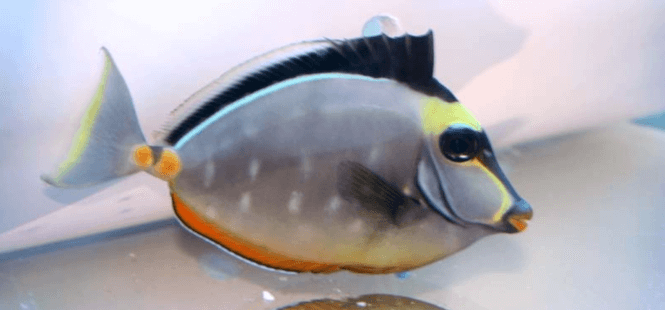
And here you can see a powder brown Tang that has acquired his white dots after stress from transportation:
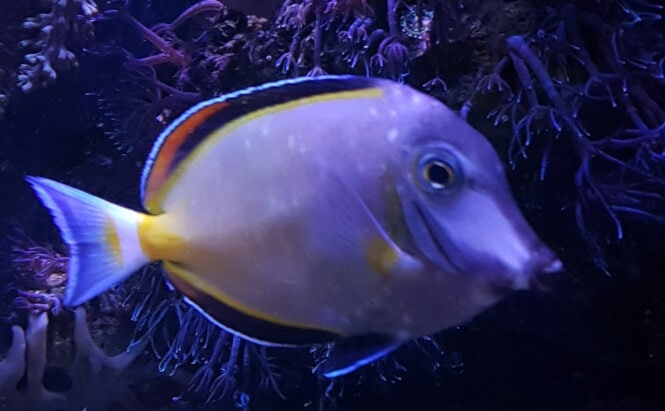
And another Naso Tang having what appears to be large white polka dots from a stressful event:
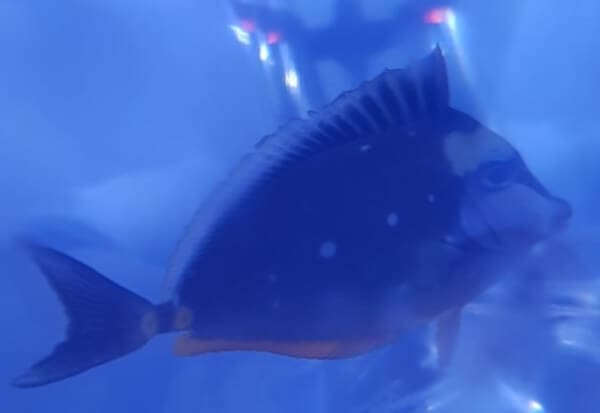
6. Columnaris
Colummaris, a bacterial infection caused by Flavobacterium columnare bacteria, usually affects the skin, gills and fins of fish. Flavobacterium columnare inhabit freshwater environments with poor water quality.
Symptoms:
- Deterioration of skin conditions due to lesions.
- White or grayish patches on skin fins or gills.
- Compromise on health conditions and loss of appetite.
- Erythema or red portion and inflamed area on skin.
- Respiratory problems.
Treatment:
It can be treated best by medicines such as antibiotics, bactericidal agents.
Antibiotics: a broad spectrum antibiotics like oxytetracycline is used to treat columnaris infection in freshwater aquariums. It can be directly added or administered orally, which inhibits bacterial protein synthesis in bacteria.
Kanamycin: another antibiotic with antibacterial activities against gram negative bacteria also works against columnaris.
Take a look at how the white patches of Columnaris look on this infected Betta and Pleco fish:
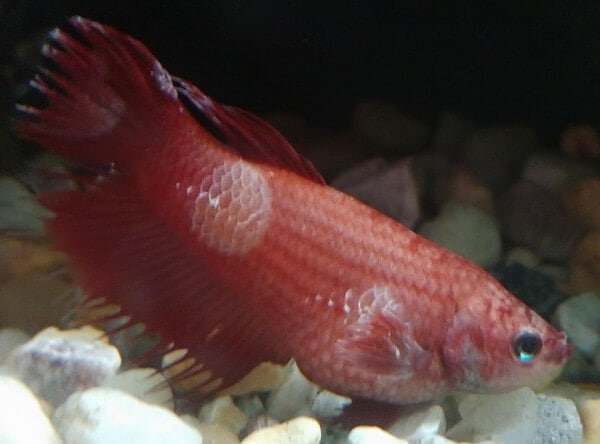
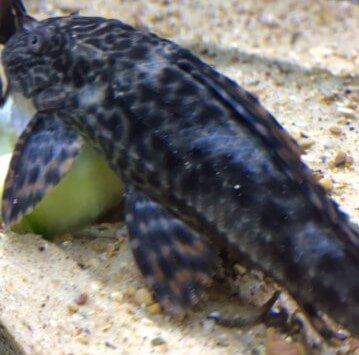
Have a look at another example of white patches forming right next to the gills of this fish:

Some of these white lesions can form around the fish’s mouth and appear raised with a cotton-like texture.
And here one black moor and one gourami that both have the white fungus-like growth around their mouths, which is actually Columnaris:
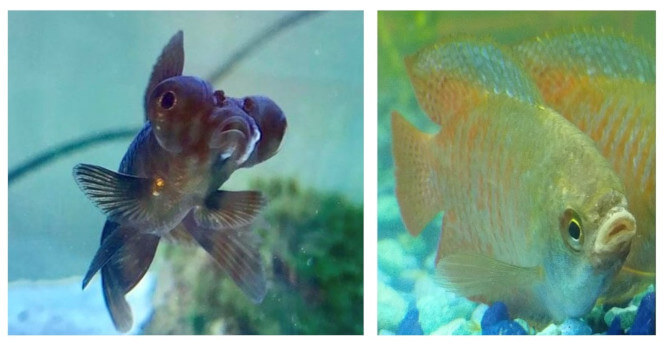
7. Fungal infection
Fungal infections are due to some underlying reasons or health conditions favorable for fungal growth such as injuries, stresses and inappropriate water quality which compromise the immune system of fish.
Predisposing factors of fungal infections:
Wound or injury: injuries to skin surface make fish susceptible to fungal infections, due to abrasions fungi can easily penetrate skin and enter the body thus causing health problems.
Poor water quality: changes in water quality and properties like pH, temperature and salinity can create an environment favorable for fungal growth.
Stress: stressful environments such as distractions, disturbances, overpopulation and aggressive tank mates weaken the immune system of fish rendering them susceptible to fungal infections.
Treatment of fungal infections:
Immediate veterinary intervention and proper treatment options be employed for elimination of fungal hyphae.
Antifungal medication: Antifungal medication like Api Pimafix which contains natural ingredients which limit fungal growth is used to treat fungal infections.it can be introduced directly into aquariums according to veterinarian’s instructions which disrupts fungal cell wall which eventually results in cell destruction.
Controlling water quality and monitoring of water parameters:
High water quality is maintained so that microorganisms and fungal growth are minimized.
Stress control:
Stressors in aquariums are eliminated such as aggressive mates, distressing health crises, disturbances.
You can see how the white fuzz appears behind this betta’s gills:
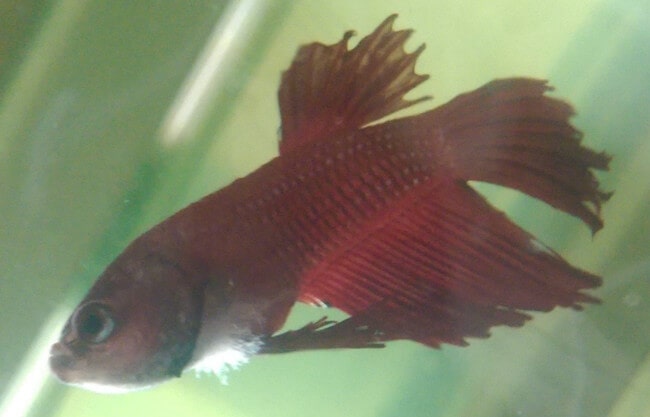
And here’s a severe fungal infection looks on another Betta:
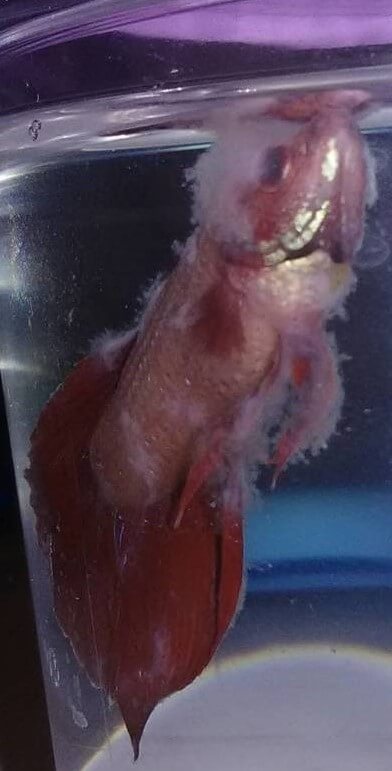
8. Parasitic Flatworms also known as Flukes
Parasitic flatworms aka flukes have flattened bodies, specialized suckers or hooks which enable them to attach on the host’s surface. It is irritating and causes inflammation and damage to tissue and cells leading to major health complications. Which are capable of living in freshwater environments and are highly adaptable posing a serious threat to aqua cultures.
Symptoms of disease:
- It manifests a wide range of symptoms such as respiratory distress, lethargy, loss of appetite.
- Skin depigmentation, discoloration.
- Habit change etc.
How to treat this disease or treatment options:
Both chemical and non-chemical treatment options are available for treatment of parasitic flatworms, which are aimed at eliminating and alleviating troubles caused by disease.
Anthelmintic medicine (praziquantel): Anthelmintic medicine can be used to treat parasitic infestation of flatworms, praziquantel is one of them. Praziquantal can be administered orally or directly into aquariums, which disrupts the nervous system of parasites leading to paralysis and neuronal degeneration.
Non-chemical therapy: for external parasites freshwater dip is the best option, in which fish is immersed deeply in a bath of dechlorinated water with controlled salinity and temperature.
Check this photograph of a clownfish that has its flukes already apparent:
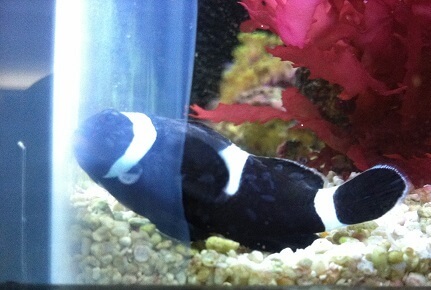
Also, see a close-up of the white raised blister-like areas on a fish’s fin:
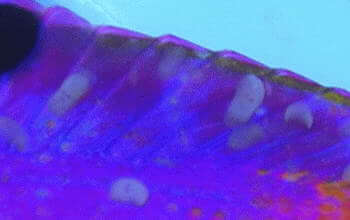
Here’s how flukes that are leaving their host after a freshwater dip look like to compare with marine ich:
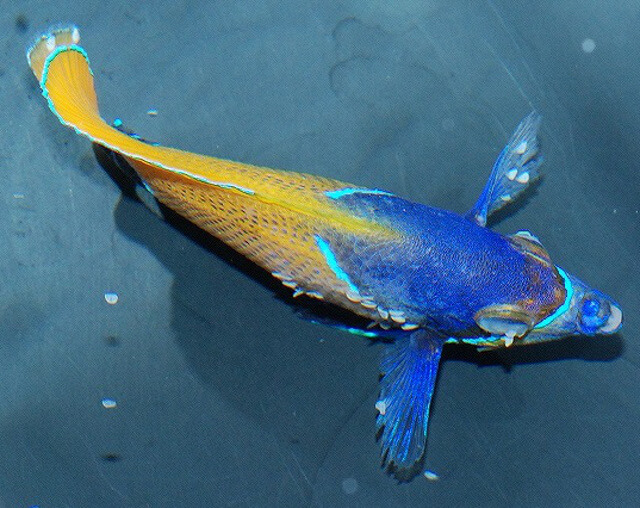
9. Missing scales
Missing scale as the name suggests, is the loss of scale or damage to scale of fish, which is a protective shield on the skin surface of fish, missing scale is due to various underlying health issues and stress or psychological issues of fish. Reasons or causes of loss of scale:
Damage or physical injury:
Physical injury to skin or external surface such as gill or underside can cause scale loss due to collision with tank surface or other hard objects.
Parasitic infestation:
Infestation of parasites dangerous to skin or scale lead to missing scales.
Bacterial infection:
Bacterial infections can cause tissue damage, gangrene and necrosis leading to loss of scale.
Poor diet and nutritional imbalance:
Imbalanced nutrition and poor quality diet can interfere with physiological functions of fish which compromise the immune system and cause loss of scale.
For identification purposes, here’s a photo of a female swordtail missing a couple of scales:
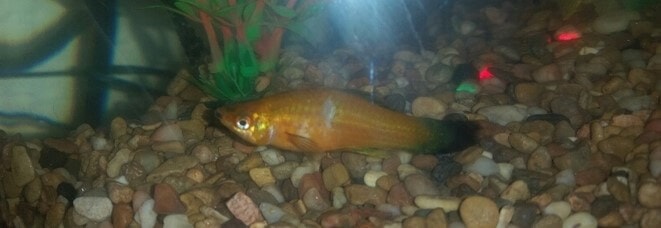
Also have a look at this goldfish that has a white patch of missing scales:
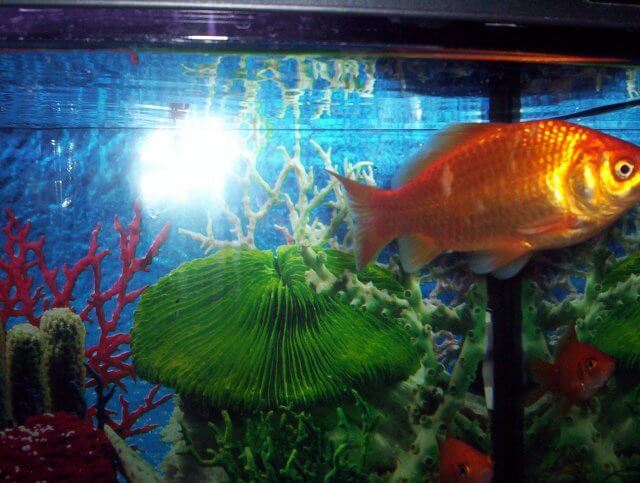
Other health Complications:
- Missing scale can cause various health concerns such as:
- Loss of aesthetic due to body damage
- Susceptibility to infections and diseases
Implications for Fish Health: Missing scales in fish can have several implications for their health and well-being:
The process of scale shedding in fish results in the exposure of underlying skin tissues, making fish more susceptible to bacterial, fungal, and parasitic infections. Secondary infections can further compromise fish health and lead to additional complications.
Scales are essential for protecting fish against physical injuries, environmental stressors, and pathogen entry. Fish with missing scales may experience heightened stress levels and reduced resilience to adverse conditions.
Scale loss may affect fish mobility and swimming abilities, particularly if the underlying skin tissues are damaged or inflamed.
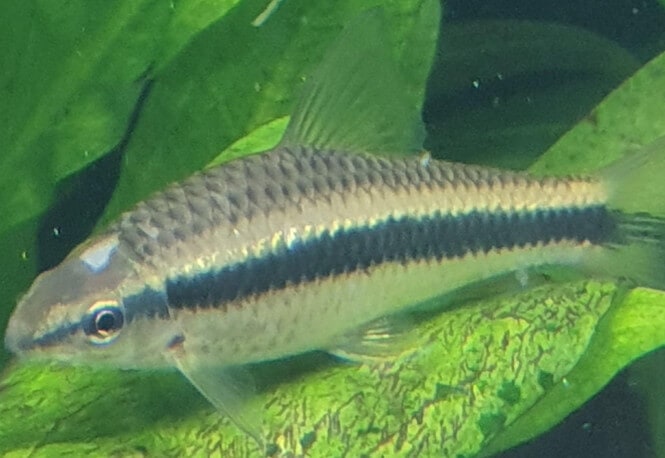
10. Epistylis
Epistylis is a protozoal disease, the protozoa with distinguishing colonies can attach to skin or gills or fish
Symptoms of epistylis :
- Deterioration of health, loss of appetite, lethargy.
- Respiratory distress, difficulty breathing.
- Mucus production.
- White stalked colonies on skin or gills.
- Rubbing against surfaces to alleviate irritation.
Treatment options for epistylis:
Treatment includes targeted immediate assistance and intervention to eradicate parasitic infestation.
Antibiotics: Antibiotics such as oxytetracycline and kanamycin are effective medicines for epistylis which disrupt symbiotic relationship between bacteria and protozoa.
These medicines can interfere with metabolism of protozoa thus leading to destruction of protozoa.
Here’s a side-by-side comparison between Ich and Epistylis:
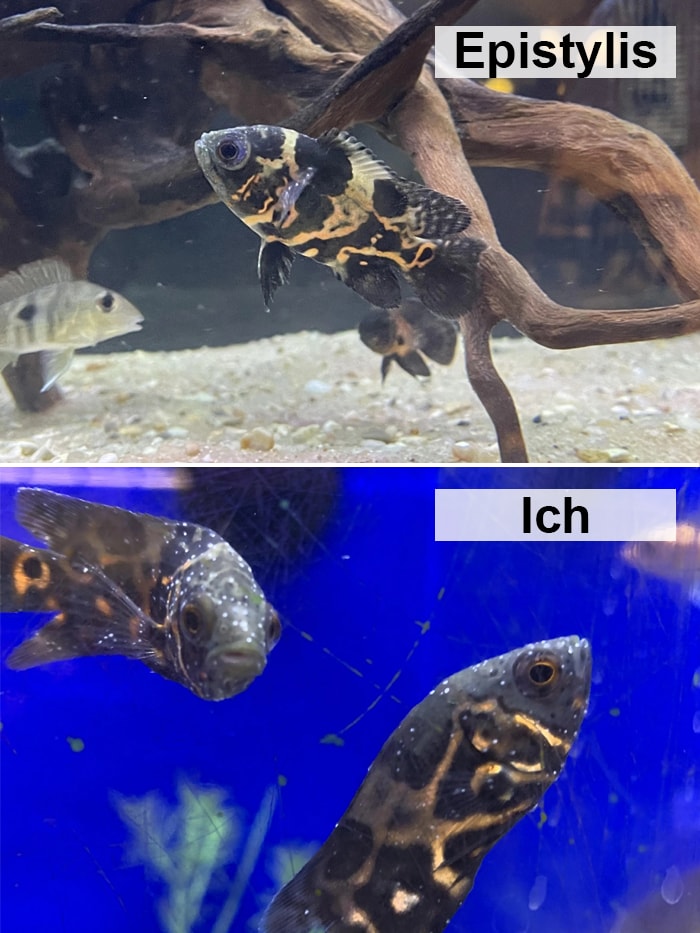
Despite the severity of this disease, all you need to treat it are antibiotics.
Unfortunately, most aquarists misdiagnose it for white spot disease, which only exacerbates its course.
Increasing the water temperature when fish are infected with epistylis will only increase the likelihood of their demise. If you suspect your fish has epistylis, consult your vet for an appropriate antibiotic treatment.
Author’s note: Epistylis often affects goldfish, loaches and other bottom dwelling species.
Prevention Of White Spot Outbreaks
There are various possible causes of a fish that has developed white spots or patches on its body, fins, or gills. Additional behavioral symptoms will help in identifying the cause in order to begin an adequate treatment and save your pets from harm.
Here are guidelines to follow when you want to treat an aquarium fish for white spots:
- Most external skin parasites in aquarium fish can be cured with chemicals such as copper sulfate, malachite green, methylene blue, and the slightly stronger formalin.
- Consider using recommended medications like praziquantel to target parasitic flatworms and flukes, which may also cause white spot-like symptoms.
- If possible, transfer infected fish to a quarantine tank for treatment to prevent spreading the infection to other tank inhabitants.
- Bacterial and fungal infections should be treated with antibiotics and antifungal medicine respectively.
- Aquarium salt is usually beneficial for skin parasites in freshwater aquarium fish, but will not be enough as a sole method of treatment. You can certainly use kosher or rock salt, but nothing that has iodine in it (like most table salt), as fish get it from their food and you don’t want it building up in their system.
- Raising the water’s temperature is always beneficial when treating external protozoan parasites, because it makes them vulnerable faster by speeding up their life-cycle.
- Freshwater dips are very effective against some common external parasites in saltwater fish, but will not be enough to treat the condition on their own.
- Most antibiotics can also obliterate beneficial nitrifying bacteria in the aquarium. Therefore an antibacterial treatment should always be carried out in a separate hospital tank.
- UV sterilizers and activated carbon media can both hinder the effectiveness of a medicine by capturing or altering its molecules. Remove them before the treatment.
- Always follow the instructions on your medicine of choice.
Treating fish with any form of white spots can be quite straightforward as long as the diagnosis is right and timely.
Prevention strategies:
- Quarantine New Additions:
- In order to prevent introduction of new pathogens like ich into the established tank environment, it is advisable to quarantine all newly acquired fish and plants prior to their placement.
- Stress Reduction:
- To mitigate the risk of infections in stressed fish, it is recommended to reduce stressors such as overcrowding, aggressive tank mates and abrupt changes in water parameters
- Hygiene Practices:
- Practice good hygiene by thoroughly cleaning and disinfecting any equipment or decorations before adding them to the aquarium.
- Avoid cross-contamination between tanks by using separate nets, siphons, and equipment for each aquarium.
Maintaining excellent aquarium water quality and a proper diet for your fish can be the difference between an aquarium crash and a long-term hobby.
Setting up a quarantine tank where you can monitor the behavior of new fish additions is one of the best ways to prevent spreading illness in your display fish tank.
Understanding Environmental Stress
It is really environmental stress and pressures which affect dominantly the immunocompromised fish which are unable to cope with such challenges.
Well- nurtured and stress- free fish can resist surmount stress are other predisposing factors of diseases.
Usually these disease causing factors are always present in an aquarium and only demonstrate themselves when they get a weakened host. The reason a fish would develop a weakened immune system is environmental stress.
Reasons which make a fish prone to disease:
- Troublesome shipping and transportation.
- Stress from aggressive tank mates or overcrowding an aquarium.
- Poor water quality, including constant nitrate levels of above 10 ppm.
- Unstable water parameters, including pH.
- Wrong or imbalanced diet that does not include vitamins.
- Water temperature fluctuations which usually happen during Fall and Spring.
Some key environmental stressors and their impact on fish:
- The presence of pollutants in the water has the potential to enhance the population growth of pathogens and opportunistic bacteria, hence resulting in the occurrence of infection and diseases in fish.
- Overcrowding in the aquarium can lead to increased competition for resources such as food, oxygen, and swimming space.
- Poor tank conditions, including insufficient hiding places, inadequate water flow, and inappropriate substrate or decor, can cause stress in fish.
- Insufficient or uneven diet intake can weaken fish immune systems and hinder their ability to resist diseases.
- The process of transportation and acclimatization process experienced by the fish might be stressful, leading to weakened immune systems and susceptibility to diseases.
- Abrupt changes in the environment can trigger physiological stress responses, making fish more susceptible to diseases and weakening the immune system of fish.
Be prepared for casualties
A big part of successfully curing most of the aforementioned diseases is spotting them on time.
If the fish has already developed a white external formation of some sort it means that the illness has been around for a while.
However, quite a few of these conditions have high mortality rates and it’s not unseen to lose a fish even after you’ve started treating it by the book.
Be mentally prepared for a grim ending.
My Conclusion
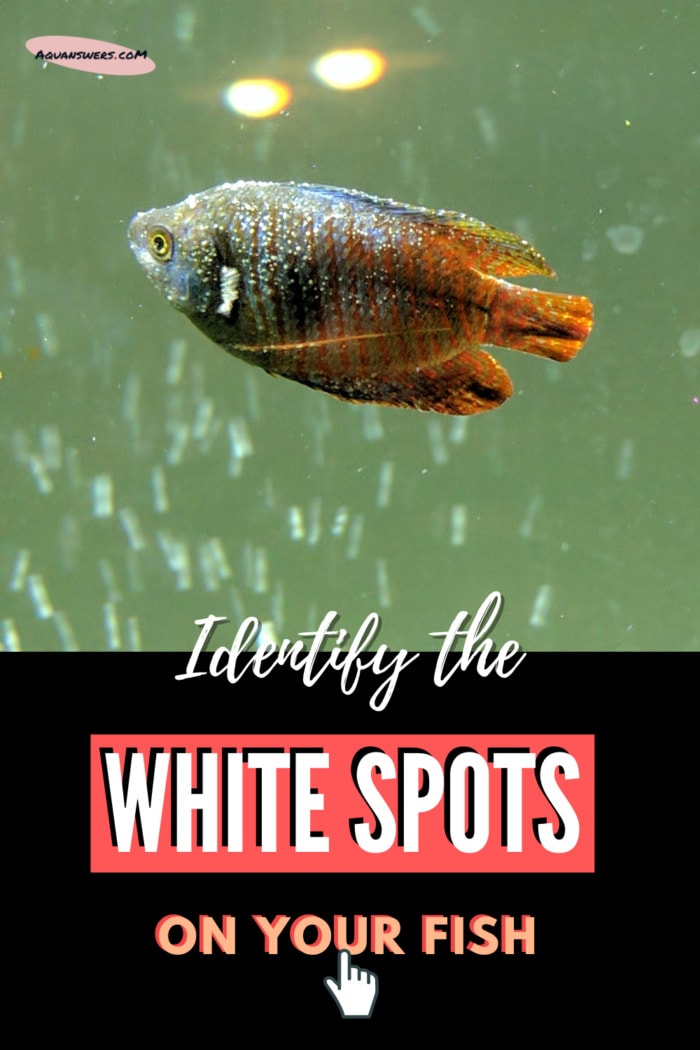
The well-being of our aquarium fish relies heavily on our vigilance, proactive measures, and swift action when it comes to disease management. By staying vigilant and prompt treatment of any signs of illness, we can intervene early and effectively, greatly improving the chances of successful treatment and minimizing the impact on our fish population.
Preparation for potential fish casualties is equally crucial. While we strive to create optimal conditions for our aquatic friends, unexpected challenges may arise. It’s essential to mentally prepare ourselves for such possibilities and have a plan in place to address them with compassion and efficiency.
Remember, each fish under our care relies on us for their health and happiness.
So, there’s no time to lose if you want to save your aquarium pet so if you’ve identified its disease based on the explanations above, I suggest treating it immediately.
Any unusual new spot on your fish, be it white or another color, is worth investigating, and most of them can be cured with immediate and early disease identification.
Comment below if you need more answers, but make sure to describe the affected body area in detail and provide information on the water parameters and recent changes made to the aquarium.


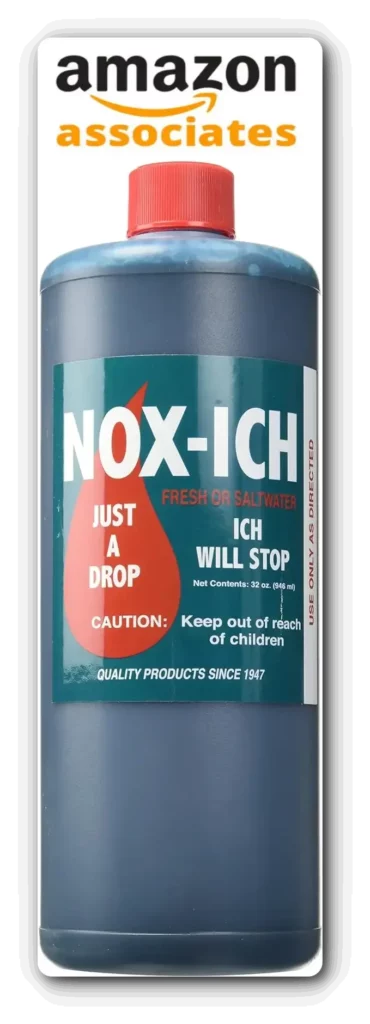

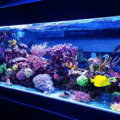
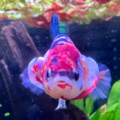
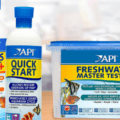
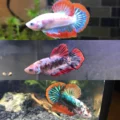
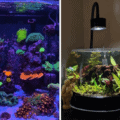
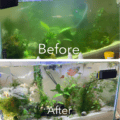
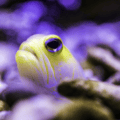


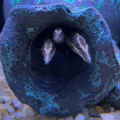
Hi. I’ve recently added more fish ro my aquarium. I noticed today that one of my original fish I had now has one white spot on its head. More like a grain of salt than fuzz I would say. It’s an odessa barb so it’s white hard to see as it moves fast. Seems OK apart from that. I was thinking ick or something but I’m confused by their just being one spot. Thank you for your time.
Hi I have a Koi Betta as part of a sorority of 8. She is not eating and hangs out at either the top corner of the tank with her bottom down or at the bottom on the sand. When she’s at the bottom, she comes up for air very often. I noticed some white coloring on her gills that I haven’t noticed before. I’m not sure if that is her color changing or something else. Its not Ick or spots, just white looking gills. She swims fine and no other Bettas are having this issue. I reviewed the top 15 Betta diseases and non of them seem to fit… any ideas?
Thank you!
Hi,
I have a black molly that has lost a couple scales. The tank has been running for 6 months or so with no issues, but the other day I noticed the pH was off- it was low. I’ve corrected that now and keeping an eye on it. The fish otherwise is acting completely normal. Black mollies are prone to fungus infections so I’m wondering if I should do anything or just wait and watch for now. I do keep the tank lightly salted at 1 tbsp/ 5 gallons. And it is a 55 gallon tank with only other female mollies.
Hi Jennifer,
pH is one of the more complex water parameters and there could be plenty of reasons for the drop. It’s weird that it did drop in a tank with added salt. I’m oversimplifying this – salts are minerals and keep the water relatively hard which in turn interacts with the pH by keeping it on the higher end unless the KH (carbonate hardness) is depleted. Confused yet?
Typically, the more KH your water has, the more stable the pH in the aquarium will be. The KH acts as a shield against pH swings of sorts.
Fixing a drop or a rise in water acidity with commercial pH regulators/buffers is generally not recommended as they can do more harm than good. However, if it’s an emergency it’s acceptable since pH swings can be detrimental to fish (6 pH is 10 TIMES more acidic than 7 pH… 5 pH is 100 TIMES more acidic than 7 pH and so on – it’s a logarithmic scale).
Anyhow, a good way to bump up the KH in your tank (which will also raise the pH) is by adding crushed coral or aragonite. This will make the water hard again.
Mollies feel excellent in hard water. In fact, they can do poorly if kept in soft water for too long. I think you’re doing good so far and you seem to have done your research. You just need to make sure your tank’s pH is stable from here on. A good start would be to figure out what led to the drop…
Anyway, did you make any significant changes to the tank before your molly started losing scales and the pH dropped? Anything you could remember? Adding purified/distilled water as a top-off method? New fertilizers? How often do you change the water?
Salt is a good precaution against fungal infections. I’m thinking it may not be fungus, but can’t be sure. I would say it’s more likely a reaction to the pH swing.
Hope this helps.
Best,
Momchil
Hello again,
I have been doing a daily 2 gallon water change in the tank for several months now. The tank parameters were holding steady until recently. I do test the water in that tank at least once a week- more if I see anything funny. I did add aragonite to the tank which stabilized the pH and it is slowly coming back up to normal. The only other thing I noticed is that in the past few days the hair algae in the tank is exploding all over with massive growth. I know hair algae is usually a problem but the mollies love to eat it and usually they eat enough that it doesn’t really grow much. That’s the only other thing I can think of.
So the hair algae explosion suggests an influx of available nutrients in the water. This somewhat alings with the drop in pH. In the context of fish keeping, water acidity increases when bacteria decompose organics. Either something died in there, or some plant mass started rotting? Note that organics does not always mean ammonia. Do you have any artificial caves, etc, which could hold pockets of waste? I’m not sure how this ties with the loss of scales, but if all of it happened at once there’s a good chance they’re connected somehow. I’m sure you did some measurements when you noticed the ill mollie? How were the parameters?
Hi, I’ve noticed two out of my 7 goldfish in my pond have new white dots on the front of their pectoral fins and gills. They did not have them two days ago. I have not introduced anything new into the pond . It has just rained for 3 days. There may have been a pice of chook poo or compost dropped in 🤷♀️🥴 I’ll attach pics if I can.
Would love your help. Thanks so much . The dots look like they are protruding from the flesh like perfectly round approximately .05mm in diameter. 1 fish has some paler patches on body not like the white dots, possible missing scales but it’s not obviously that.
Hi, Nicole,
Did the temperatures drop suddenly during the rainy days? Goldfish are resilient but not immune to violent temperature fluctuations.
It sounds like a typical protozoan outbreak if what you’re saying is accurate and my assumption is correct.
Do the dots visually resemble any of the photos in my article?
Momchil
Hi, I have two small Shubunkin gold fish in a 30 gal aquarium. I’ve noticed their gills look really red, no ammonia. I did test for that. I also did a water change, prob 60% just to be sure. One of them I have noticed also has tiny white dots visible on one side of his gills. I don’t see any on their bodies or on the other fish. None of pics above look like what I’m seeing. I believe it’s been there close to two weeks now. I am new to the shubunkin fish, only had guppies or Molly’s pretty much. I would be happy to share a picture of my fish showing what I am seeing. Do you know what this could be and what I can do for it?
I have a 75 gallon heavily planted freshwater tank with CO2. It contains 6 Amazon pea puffers, 3 panda garras, and 3 loaches. I noticed the heater wasn’t on and water was pretty cool, I believe this had been about 3 days. I fixed heater. So drop in water temp of about 7-8 degrees. About a week later I noticed spots on my puffers. I treated with seachem Praguard for 3 days. Spots look worse. No spots on cory’s or loaches. What should I do next? Water parameters are perfect. Sand substrate with plant substrate under. No change in fish activity or appetite. TIA
three of the goldfish in a tank in my classroom have gained white spots localised to the top of their gills, and are not visible anywhere else on their bodies. the spots don’t really resemble any of what is shown here in this article, do you have any idea of what this could be? thanks
We had 2 sick German Blue Rams. The male showed signs of sickness first: rapid breathing, resting on bottom of tank, darkened allover color,, and then 3 white specks on 1 side of his body. At this point, we moved both Rams to a hospital tank and treated for Ick. The female started to show similar behavior at this point, but no spots. The male died anyway but the female perked up, brightened, and seemed happy- but then also showed white spots a day later. Her spots were on her fins rather than her body. We treated for Ick twice more. Behavior remained good but spots remained. We did a salt dip. Again, behavior great, but spots actually grew. Its now 2 radial lines of sand white texture on her dorsal fin and 2 specs on her tail and anal fins. What could it be??
Hello, thanks for putting all of this together. I have 2 Goldfish ( one black the other gold) and one plecostomus. Pretty much over night my black goldfish developed a combination of smaller white dots, and also larger white patches, covering about 7% in various locations, including the very tips of his fins, the other 2 fish seem unaffected. They’re in a 36 gallon tank, which I do partial water changes and vacuum the gravel weekly. The only change that has happened recently is running out of seachem prime and using aqueon water conditioner. (I don’t have anything to test the water though) Wondering what your initial guess would be, my initial guess is ich, but I’m hesitant to chemically treat them for it. As a quick first aid measure I did a 50% water change and have raised the temperature to around 75 degrees. Any thoughts?
Hi,
You say there are also patches and not just dots. Ich is always dots and never patches. So I would say not ich. Unfortunately, without a clear photo, there is little that can be said.
In your opinion, which of the described and illustrated illnesses above describe what you’re seeing best?
Best, Momchil
I think I got a little fixated on ich to consider other conditions. Every white patch is missing scales. It’s a good example of considering what has changed in their environment, so it’s possible that Seachem prime could of been controlling the nitrates which is good but also misleading as it meant not testing often. Along with raising the temperature I later added aquarium salt as if treating ich, he suddenly perked up which was unexpected.
Just moved goldfish outside for the summer and one has white on its head and dorsal fin.
Hi,
What’s the texture, shape, etc?
Do you see the goldfish scratching on surfaces?
Momchil